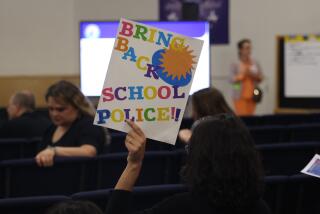Poll Shows Increased Concern for Parent, Financial Support of County’s Schools
Although drug abuse is still considered the No. 1 problem facing San Diego County’s public schools, public concern has decreased as attention to lack of monetary and parental support increased, according to a survey released Wednesday by the County Office of Education.
The percentage of people who identified drug abuse as the biggest problem facing schools in 1990 fell by 7 points from 1989, from 42% to 35%. Classroom crowding was the second most frequently cited problem with 12%, as it was in the first two years of the survey, conducted by a private polling firm.
The open-ended question, “What do you think are the biggest problems with which the public schools in your community must deal?” was asked of 1,500 people in the county, as part of the county Board of Education’s attempt to increase public support for schools. The results will be considered when the board allocates its resources.
“Drugs have been a problem in schools for a number of years,” said Bob Meadows, president of the polling company contracted by the board. “So maybe people are focusing on other problems. It’s like, ‘We know we have this problem, but we’ve got some other problems too.’ ”
The lack of parental involvement was named by 10% of respondents and lack of funding was cited as the worst problem by 11%. In 1989, both of those problems were named by 6% of the public.
Interviewers phoned a random sample of people over the age of 18 and asked a variety of questions. More than 70% of those polled blamed society for problems facing schools, while only 11% blamed the schools themselves. When asked about how parents rate in raising their children, 33% of those polled gave parents a grade of C, compared to a combined 30% that gave parents an A or B grade.
The public gave San Diego schools an overall performance grade of B-minus, supported year-round schooling with a 60% vote, and a majority said they feel that teachers were fairly paid.
Parents of children attending public schools consistently gave more favorable ratings to the schools than did people without children in school.
“I think those who get their information from schools and teachers know about the good things going on,” said Marty Block, county school board member. “Those who get their information from newspapers and television . . . often get negative information, so their opinions are negative.”
Block said the study has shown the board that people without children attending schools are probably the ones voting against bond measures that would bring in money to build schools and ease crowding. He said an effort is under way to target this group in future campaigns.
The survey cost the county board about $25,000. Six districts paid extra for extra questions to be asked in their communities related to special issues such as unification.
GRADE PARENTS RECEIVE FOR RAISING THEIR CHILDREN
A: 6%
B: 24%
C: 33%
D-F: 17%
Don’t Know: 20%
Source: Decision Research
More to Read
Sign up for Essential California
The most important California stories and recommendations in your inbox every morning.
You may occasionally receive promotional content from the Los Angeles Times.










